|
|
|
 |
| Discover
Natural Egypt |
 DIVING DIVING
A Red Sea diving
holiday in Egypt
is simply
unforgettable.
Well-established
diving centres
will gladly
provide you with
scuba diving
information and
arrange courses,
daily
excursions, and
live-aboard
trips to almost
anywhere, from
the gigantic
coral outcrops
of Taba to the
vertical walls
of Ras Mohammed,
from the wrecks
of Sha'ab Abu
Nuhas to the
lonely offshore
islands of The
Brothers and
Zabargad. The
Red Sea is
dubbed Egypt’s
“Garden of
Allah”, due to
the wealth of
underwater
pristine life.
The Egyptian Red
Sea offers the
world's best
scuba diving: at
only a few hours
by plane from
Europe, you find
superb
visibility (up
to 50 metres),
abundant and
diverse fish
life (over 1,000
species),
countless
varieties of
hard and soft
coral (over 400
species),
year-round
diving in
comfortable
water
temperatures
(18° to 26°
Celsius),
incredibly
diverse
underwater
topography,
spectacular wall
and shipwreck
destinations,
sunny weather
and pleasant air
temperatures
(18° to 40°
Celsius), and
easy access to
diving
locations.
Browse through
our Red Sea dive
sites maps and
you will be
impressed by the
range of diving
possibilities.
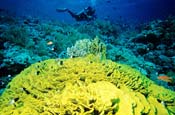 It
is no surprise
therefore that
Red Sea diving
is one of the
most
sought-after
holidays.
Whether a
hopeful wannabe
or expert diver,
eight year-old
kid or sporting
grandmother,
diving can be
experienced and
enjoyed by
nearly everyone. It
is no surprise
therefore that
Red Sea diving
is one of the
most
sought-after
holidays.
Whether a
hopeful wannabe
or expert diver,
eight year-old
kid or sporting
grandmother,
diving can be
experienced and
enjoyed by
nearly everyone.
The Red Sea is
an enormous
basin, 2350km
(≈1400 miles)
long by about
350km (≈220
miles) broad at
its widest
point, enclosed
to the north by
the Gulfs of
Suez and Aqaba,
and at its
southernmost
point the Bab
el-Mandeb
Strait, which is
hundreds of
metres deep. The
sea is has a
truly unique
ecosystem,
surrounded as it
is, by red-hued
bauxite
mountains that
some believe to
be the origin of
the name Mare
Rostrum – the
Red Sea. It was
formed 25
million years
ago by the
separation of
the African
Continent from
the Arabian
Peninsula. It is
distinguished by
the volcanic
activity in its
shallows, its
regular
currents, the
small tidal
range, a salt
content of 4.1%
(the world’s
seas average
3.2%), and a
water
temperature that
drops only
slightly in its
depths.
The Red Sea has
been a
commercial
highway between
the East and the
West since
classical
antiquity. Boats
departed loaded
with copper,
pottery, and
cloths to return
laden with
silks, spices,
wood, and even
elephants. The
cutting of the
Suez Canal in
1869 boosted and
encouraged a
tradition of
many centuries
of sailing,
interspersed
with shipwrecks
and piratry.
Today the Sea is
an essential
destination for
divers the world
over.
 AN
ARMY OF
BUILDERS: THE
CORALS AN
ARMY OF
BUILDERS: THE
CORALS
Over 250 species
of coral exist
in the Red Sea,
8% of which are
endemic. The
organism is made
up of “heads” of
polyps.
Half animal and
half vegetable,
the corals have
invaded the
reefs like an
army of
builders. When a
colony dies,
another starts
building on its
calcareous
skeleton… But
this activity
can be
misleading as,
depending on the
species, it only
grows at a rate
of a few
millimetres or
centimetres per
year – so it
takes thousands
of years for the
coral to carpet
the seafloor and
model out the
relief.
A GIANT
AQUARIUM
With 1248
species, of
which 17% are
endemic, the Red
Sea is like a
magnificent
aquarium, and
its reefs are a
haven for many
species of fish.
Some use them to
hide from
predators,
others lay their
eggs there, and
for most the
reefs are their
feeding grounds.
F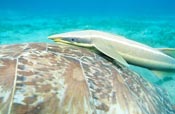 ATAL
ATTRACTION ATAL
ATTRACTION
There is a
seemingly
infinite aquatic
palette of
shapes, colours,
spots, and
stripes. But
great care must
be taken – it is
forbidden to
touch these
creatures, and
some of them can
be dangerous.
So, keep your
hands out of
harm’s way and
concentrate on
controlling your
buoyancy
instead!
THE PREDATORS
Although they
are rarely
aggressive in
the Red Sea, it
must always be
remembered that
sharks are
predators.
Resist the
temptation to
provoke a
reaction from
reef and
whitetip sharks,
which are known
for their
curiosity and
timidity, and
the nurse sharks
that skim the
seafloor. The
vast majority of
sharks are found
away from the
reefs, like the
curiously shaped
hammerhead
shark, or the
leopard shark,
with the same
spots as his
terrestrial
counterpart, and
less frequently
you can
encounter the
oceanic whitetip
shark (Longimanus)
and the whale
shark, the real
colossi of the
seas.
UNDERSEA LIFE
AROUND THE
WRECKS
The wrecks
provide the
ideal
environment for
a whole range of
different
organisms:
alcyonarians,
fan corals, and
stony corals can
transform the
rustiest of
hulls into a
wonderful garden
that is home to
shellfish,
molluscs,
parrotfish, and
also morays,
lionfish, and
crocodilefish.
But, the star of
the wrecks is
undoubtedly the
grouper, the
ever-present
guardian of
sunken ships.
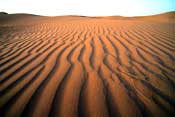 CAMPING CAMPING
With so much
outstanding
natural and
man-made scenery
to explore and
such a welcoming
climate, camping
is a great way
to see Egypt on
your own.
You can spend
your nights
beneath the
starlit skies of
the Western
Desert and then
explore its lush
oases : the
Bahariya, the
Farafra and the
Dakhla, during
the day. Or, if
you're a
die-hard
explorer, you
can brave the
remote, rippling
sandscapes of
Great Sand Sea
with its cool
nights and
spectacular
views. The Nile
is also a good
place to pitch
your tent in the
shadows of the
Pyramids.
Make sure you're
fully stocked up
on all the
essentials,
especially
water.
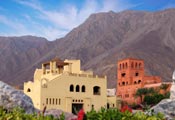 TREKKING TREKKING
Whether you're
looking for
mountains to
climb or plains
to trek, sands
to stroll or
oases to
explore, Egypt's
astonishing
diversity of
natural terrains
and landscapes
are the perfect
ingredients for
some truly
memorable
trekking.
The lush, green
oases of the
Western Desert :
Bahariya,
Farafra and
Dakhla, are
packed to the
gills with
historical gems
from the
Pharaonic,
Graeco-Roman and
Islamic
Dynasties.
•If you're
looking for open
sands, the Great
Sand Sea might
be more your cup
of tea. But if
you're after a
rockier ride,
the mountainous
peaks of the
Sinai Peninsula
or Jebel Uweinet
are the best
places to go.
•Test all your
equipment before
setting off.
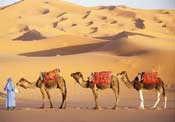 Trekking
locations : Trekking
locations :
You can trek
almost anywhere
you like. If
you're looking
for some culture
along the way,
the oases
Bahariya,
Farafra, Dakhla
and Siwa are
your best
options. There
are endless
sandscapes in
the Western and
Eastern Deserts
and in the Great
Sand Sea on the
Sahara. There
are also
mountains at
Jebel Uweinat
and at Sinai
Peninsula
BIRD WATCHING
In Egypt you can
combine bird
watching with
sightseeing as
birds have
always played
important roles
in both the
secular and
sacred spheres
of Egyptian
culture. Falcon,
hawk and
vulture-headed
gods, the
splendid frieze
of the 'Medium
Geese' and the
heron-like Bennu
bird (the
Egyptian
correspondence
to the phoenix,
a mythical
sacred
firebird), are
only a few of
over 76 bird
species that can
be identified in
many other wall
paintings,
reliefs and
artefacts.
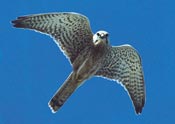 Amateur
ornithologists
have been
searching the
skies for well
over a century.
With improved
environmental
protection and
conservation,
Egypt's national
parks are a
delight for
budding bird
watchers. Over
150 indigenous
species of birds
live all year
round in Egypt
and another 280
migrate from
their winter
homes to the
Nile's fertile
banks. Amateur
ornithologists
have been
searching the
skies for well
over a century.
With improved
environmental
protection and
conservation,
Egypt's national
parks are a
delight for
budding bird
watchers. Over
150 indigenous
species of birds
live all year
round in Egypt
and another 280
migrate from
their winter
homes to the
Nile's fertile
banks.
From the herons
and flamingos of
Lake Bardawil to
the blue-cheeked
bea eaters of
Wadi Natrun, and
from the
songbirds and
sunbirds of the
lush Nile Valley
to the ospreys
and eagles of
the Ras Mohammed
National Park,
there are
endless
opportunities
for bird
watching all
along the Nile,
the Suez, the
Red Sea coast
and Egypt's
great lakes and
oases. |
|
|
|
|